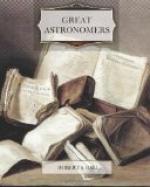The Astronomer Royal was a capable, practical engineer as well as an optician, and he presently occupied himself by designing astronomical instruments of improved pattern, which should replace the antiquated instruments he found in the observatory. In the course of years the entire equipment underwent a total transformation. He ordered a great meridian circle, every part of which may be said to have been formed from his own designs. He also designed the mounting for a fine equatorial telescope worked by a driving clock, which he had himself invented. Gradually the establishment at Greenwich waxed great under his incessant care. It was the custom for the observatory to be inspected every year by a board of visitors, whose chairman was the President of the Royal Society. At each annual visitation, held on the first Saturday in June, the visitors received a report from the Astronomer Royal, in which he set forth the business which had been accomplished during the past year. It was on these occasions that applications were made to the Admiralty, either for new instruments or for developing the work of the observatory in some other way. After the more official business of the inspection was over, the observatory was thrown open to visitors, and hundreds of people enjoyed on that day the privilege of seeing the national observatory. These annual gatherings are happily still continued, and the first Saturday in June is known to be the occasion of one of the most interesting reunions of scientific men which takes place in the course of the year.
Airy’s scientific work was, however, by no means confined to the observatory. He interested himself largely in expeditions for the observation of eclipses and in projects for the measurement of arcs on the earth. He devoted much attention to the collection of magnetic observations from various parts of the world. Especially will it be remembered that the circumstances of the transits of Venus, which occurred in 1874 and in 1882, were investigated by him, and under his guidance expeditions were sent forth to observe the transits from those localities in remote parts of the earth where observations most suitable for the determination of the sun’s distance




